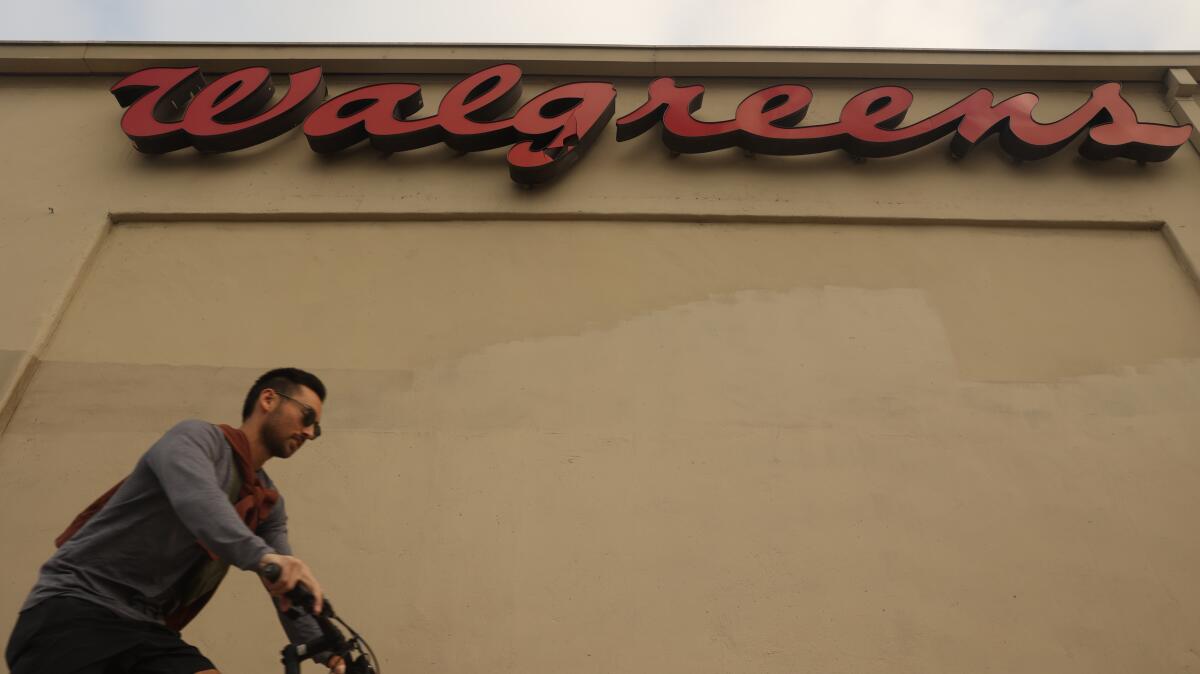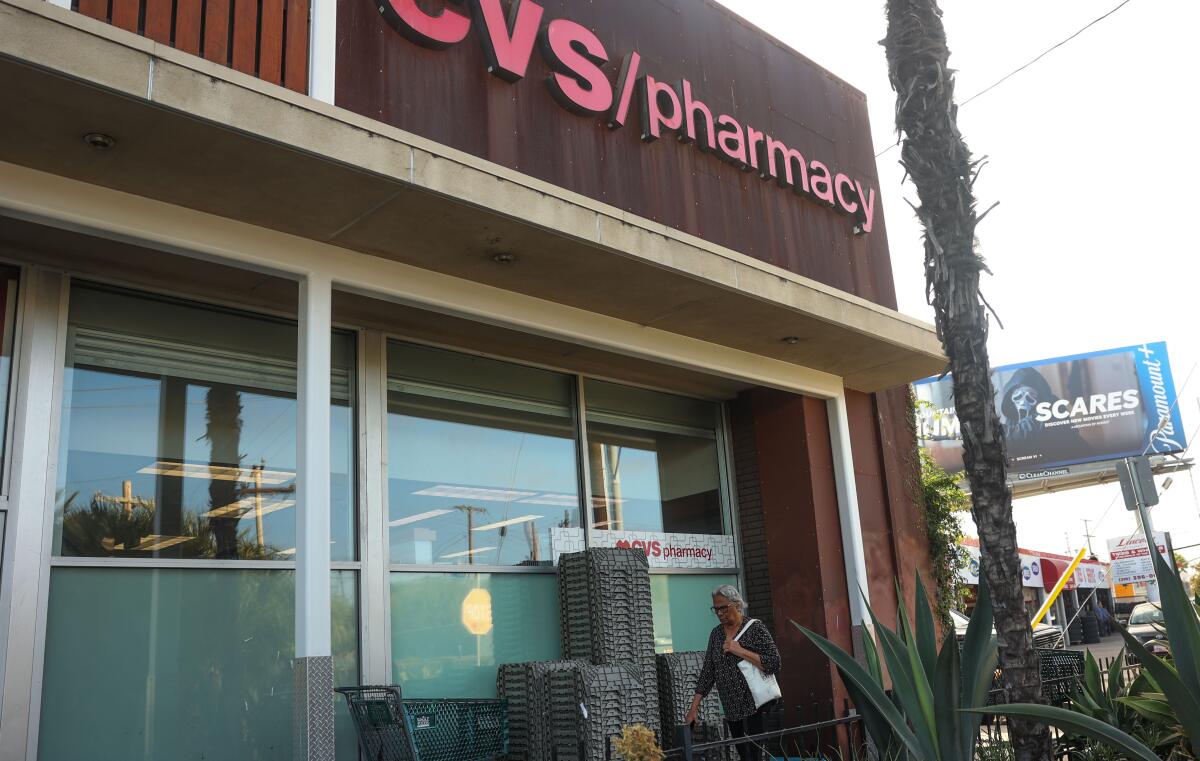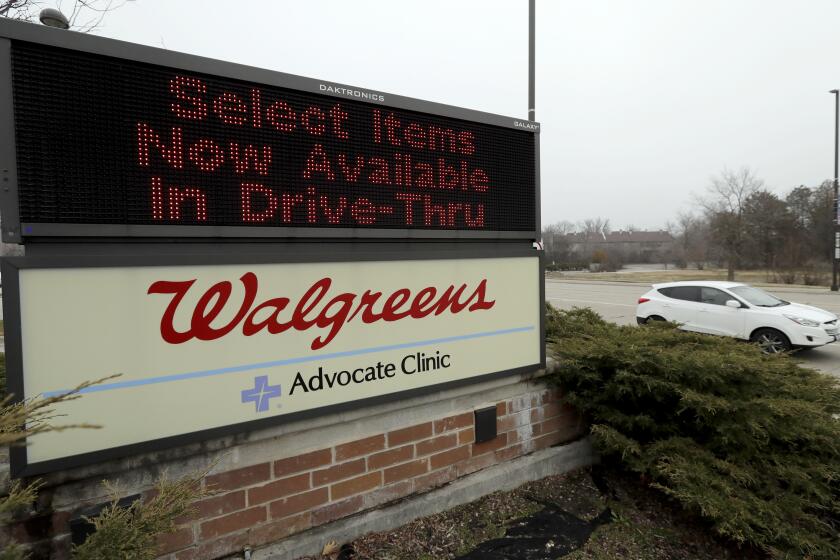‘My kids go to Costco now,’ and other reasons Rite Aid, Walgreens and CVS are hurting

- Share via
These are tough days for pharmacy chains.
From Gardena to Venice to Koreatown, storefronts that used to be Rite Aid drugstores sit empty. On Lincoln Boulevard, the outline of the Rite Aid logo can still be seen above shuttered doors.
The retail pharmacy chain has closed more than 200 stores since filing for Chapter 11 bankruptcy protection in 2023 and announced plans in July to shut down 18 more locations in California as it struggles to deal with creditors and lawsuits over opioid prescriptions.
Competitors CVS and Walgreens are also cutting costs and closing stores, reflecting challenges in the industry that have been brewing for years but have recently begun to accelerate, experts say. In June, Walgreens’ chief executive said about a quarter of the company’s 8,600 U.S. stores were underperforming and that a “significant number” of them could be closed.
Walgreens, CVS and Rite Aid are not in identical financial positions, but all three are being forced to examine their footprint and business model as they deal with lowering margins and changing consumer trends.
“Between the pressure on the front of the store plus the pressure on the pharmacy, it’s just getting harder and harder for these guys to operate,” said Brian Tanquilut, an industry analyst at Jefferies.
The pharmacy chains have discovered that taking a larger role in the healthcare system than simply dispensing prescriptions and selling over-the-counter notions is more complicated and costlier than they expected.
On the retail side, chain pharmacies are facing heavy competition from giants such as Amazon and Walmart, a drop in consumer spending and an increase in theft that can eat into profits, analysts said. On the pharmaceutical side, they’re seeing lower margins because of lower reimbursement rates for the drugs they provide to customers.
Much of the pharmacy pinch is rooted in the companies’ dependence on intermediaries called pharmacy benefit managers, or PBMs, who have significant control over how much pharmacies get reimbursed for the drugs they sell to customers.
Two of the largest benefit management companies, OptumRX and Caremark, are owned by insurance companies that have been looking to cut costs by pushing down reimbursement rates, which has punished the pharmacies’ bottom lines.
“The PBMs, all of which now are owned by the insurance companies, have been squeezing what they pay for drugs,” Tanquilut said. “As that has continued to come down, the profitability of these pharmacies has also waned,” he said.
Overall, the three pharmacy chains have struggled on Wall Street this year.
Walgreens stock price, which closed Friday at $9.25, has plummeted more than 65% since the start of the year. In June, when it missed earnings expectations for the quarter, the company warned investors it was bracing for more gloomy performance figures and cut its financial forecast for the fiscal year that ended in August.

Rite Aid’s languishing stock, meanwhile, took a nosedive when the company entered bankruptcy late last year and the New York Stock Exchange moved to delist it.
Pharmacy benefit managers were developed to help cut prescription prices. Instead, they’ve become a major driver of higher prices.
CVS stands on slightly more solid ground, said Raymond James healthcare analyst John Ransom, because it owns insurance company Aetna, as well as Caremark, the pharmacy benefit manager.
“CVS is an integrated company,” Ransom said. “They’ve been able to integrate Caremark into the drug retail business in a way that’s made the drug retail business more healthy.”
But that has not made the company immune to market forces. Its stock, which closed at $57.24 Friday, is down 29% this year. CVS slashed its financial outlook and embarked on a $2-billion cost-cutting plan in early August. The company has also been closing locations since 2021, when it announced a realignment plan that would close 900 stores over three years.
CVS is on track to finish its store closures by the end of this year. After the closures, 85% of U.S. residents will still live within 10 miles of a CVS, said Amy Thibault, lead director of external communications for the company.

“The store closure decisions are based on population shifts, consumer buying patterns, a community’s store density, maintaining access to pharmacy services, and future health needs to ensure we have the right kinds of stores in the right locations for consumers,” she said.
There is an overcrowding of drugstores in the country partly as a result of a real estate binge in the ‘90s, Ransom said.
“They’re shutting these stores down in urban markets where you go to a street corner and you see four pharmacies,” he said. “I think part of it is they did it to themselves.”
Walgreens is finalizing a plan to fix its business that could result in the closure of hundreds of additional stores in the next three years
Walgreens external communications manager Samantha Stansberry said the company is being affected by increased regulatory and reimbursement pressures as well as higher levels of inflation, theft and other types of losses.
“Like most retailers, we have been facing a challenging operating environment,” Stansberry said. “These factors have resulted in a growing number of store closures across the country as we invest in our other locations to deliver a consistent customer experience.”
Walgreens was poised to acquire Rite Aid in a merger in 2015, but the deal ultimately fell through.
Koreatown resident Darleen Stoker was recently shopping at a Rite Aid on Larchmont Boulevard in Hancock Park and noticed rows of empty shelves. She wondered if it was a sign that the location was closing, she said.
“My kids go to Costco now,” Stoker said. “Rite Aid is more for when you realize last minute you need nail polish.”
Other customers in the store said the shelves have been empty for at least two months.
Rite Aid did not respond to multiple requests for comment.
“The remaining Rite Aid stores face a lot of the challenges that they were facing when they were trying to bridge with Walgreens,” Tanquilut said. “It’s a lot of pressure from other retailers, whether that’s the dollar stores, the Walmarts, the Targets of the world, or online retail like Amazon.”
Retail pharmacies are also struggling to adapt to a changing consumer more focused than ever on value, Tanquilut said. Customers have started to realize that sodas cost less at a grocery store than a drugstore, he said.
As inflation drives everyday costs up, consumers are tightening their belts and may be limiting impulse purchases on items found at a drugstore such as snacks and beauty products. A significant portion of purchases at drugstores are spontaneous, Tanquilut said, as customers roam around waiting for their prescription.
Tanquilut said the closing of locations could help CVS, Walgreens and Rite Aid weather the harsh industry conditions that have prompted cost-cutting measures. The density of pharmacies in the country is higher than it needs to be, he said.
“We are ‘over-pharmacied’ as a society,” Tanquilut said. “From a profitability perspective and from a competition perspective, reducing the number of retail pharmacies is not a bad thing.”
More to Read
Inside the business of entertainment
The Wide Shot brings you news, analysis and insights on everything from streaming wars to production — and what it all means for the future.
You may occasionally receive promotional content from the Los Angeles Times.












